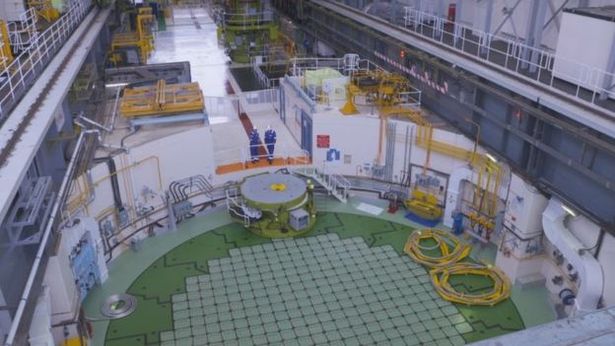Cracks Found in Nuclear Reactor That Could Lead to the Full Evacuation of Edinburgh and Glasgow
ENERGY, EUROPE, ENVIRONMENT, 11 Mar 2019
Edinburgh Live – TRANSCEND Media Service
The Hunterston B reactors in Ayrshire are the oldest in Europe, and dangerous cracks have been found.
8 Mar 2019 – Bottom of FormThe two reactors at Hunterston B nuclear power plant near Ardrossan are 43 years old – the oldest in Europe.
They’re already well beyond their operating lifetimes, which have twice been extended by EDF Energy, and they’re scheduled to close down for good in 2023.
However, there’s a serious safety fault in the reactors. The fault is known as keyway root-cracking: where the graphite moderator cores in the reactors develop cracks leading to instabilities that could lead to a major nuclear accident: which would lead to a large swathe of Scotland’s central belt having to be evacuated.
“In the very worst case the hot graphite core could become exposed to air and ignite leading to radioactive contamination of…the metropolitan areas of Glasgow and Edinburgh.”
The reactors have been closed since October 2018 as a result, but owners EDF Energy are currently making a case for turning them back on, with help from trade union GMB.
Although the probability of a meltdown is still low, the consequences could be incredibly severe. In such an event, both Glasgow and Edinburgh would need to be entirely evacuated due to radioactive contamination.
Read More: Man arrested following discovery of ‘suspicious item’ in Annandale Street last week
According to Dr Ian Fairlie, an independent consultant on radioactivity in the environment, and Dr David Toke, Reader in Energy Policy at the University of Aberdeen, the two reactors definitely should not be restarted. Speaking about the cracks in the barrels, they say:
“This is a serious matter because if an untoward incident were to occur – for example an earth tremor, gas excursion, steam surge, sudden outage, or sudden depressurisation, the barrels could become dislodged and/or misaligned.
“These events could in turn lead to large emissions of radioactive gases. Further, if hot spots were to occur and if nuclear fuel were to react with the graphite moderator they could lead to explosions inside the reactor core.
“In the very worst case the hot graphite core could become exposed to air and ignite leading to radioactive contamination of large areas of central Scotland, including the metropolitan areas of Glasgow and Edinburgh.”
Station Director Colin Weir said: “Nuclear safety is our overriding priority and reactor three has been off for the year so that we can do further inspections.
“We’ve carried out one of our biggest ever inspection campaigns on reactor three, we’ve renewed our modelling, we’ve done experiments and tests and we’ve analysed all the data from this to produce our safety case that we will submit to the ONR.
“We have to demonstrate that the reactor will always shut down and that it will shut down in an extreme seismic event.”
The operational limit for the latest period of operation was 350 cracks but an inspection found that allowance had been exceeded.
EDF plans to ask the regulator for permission to restart with a new operational limit of up to 700 cracks.
Go to Original – edinburghlive.co.uk
DISCLAIMER: The statements, views and opinions expressed in pieces republished here are solely those of the authors and do not necessarily represent those of TMS. In accordance with title 17 U.S.C. section 107, this material is distributed without profit to those who have expressed a prior interest in receiving the included information for research and educational purposes. TMS has no affiliation whatsoever with the originator of this article nor is TMS endorsed or sponsored by the originator. “GO TO ORIGINAL” links are provided as a convenience to our readers and allow for verification of authenticity. However, as originating pages are often updated by their originating host sites, the versions posted may not match the versions our readers view when clicking the “GO TO ORIGINAL” links. This site contains copyrighted material the use of which has not always been specifically authorized by the copyright owner. We are making such material available in our efforts to advance understanding of environmental, political, human rights, economic, democracy, scientific, and social justice issues, etc. We believe this constitutes a ‘fair use’ of any such copyrighted material as provided for in section 107 of the US Copyright Law. In accordance with Title 17 U.S.C. Section 107, the material on this site is distributed without profit to those who have expressed a prior interest in receiving the included information for research and educational purposes. For more information go to: http://www.law.cornell.edu/uscode/17/107.shtml. If you wish to use copyrighted material from this site for purposes of your own that go beyond ‘fair use’, you must obtain permission from the copyright owner.
Read more
Click here to go to the current weekly digest or pick another article:
ENERGY:
- China Opens World’s Largest Offshore Solar Power Facility
- Nuclear Industry Takes Control of NASA
- The Nuclear Energy Dilemma: Climate Savior or Existential Threat?
EUROPE:
- Raised in a Colonial Death Cult: 600 Years of KU Leuven and still...
- The Rise of ‘Antidiplomacy’ in a Powerless Europe
- ‘Diplomatic Tsunami’ Nears as Europe Begins to Act against Israel’s ‘Complete Madness’ in Gaza
ENVIRONMENT:
